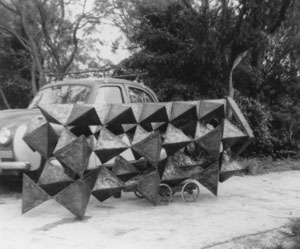
Castlecrag is one of four communities selected for an exploration of ‘Life in the Australian city’, one of ten broad themes governing the National Museum of Australia’s (NMA) new permanent gallery due to open in August 2009.
The Creating a Country Gallery aims to represent the encounters of ideas, people and places that are signposts in the evolution of Australia’s social, political and economic forms. The detailed explorations of particular places will reveal the circumstances that produced these historical encounters, locating them in their geographical and social contexts.
For the exhibit on the Australian city, the NMA has deliberately avoided an abstract centred on the usual themes of the colonial townscape, changes to transportation and the growth of suburbia. This exhibit, like all the others in the new gallery, considers its theme from the perspective of place. Castlecrag will stand alongside displays on Bennelong Point, suburban Brisbane in the late-nineteenth century and Rottnest Island in Western Australia. Visitors will be encouraged to view each place as a particular reflection about how we have built our cities, how they have changed, and how we have responded to life in an urban environment.
The history of Castlecrag offers a fascinating way of exploring and reflecting on the ideas and values that have shaped our homes and our cities. An exhibit on Castlecrag has many tantalizing possibilities. Broadly speaking, the exhibit aims to introduce visitors to the Griffins’ social and architectural vision for a planned residential community. While the objects will tell how Marion and Walter went about building a unique suburban plan, visitors should leave with a strong sense of the Griffins’ philosophical understanding of urban life, the fusion between the natural and built worlds and the kind of society they dreamed of fostering.
The Castlecrag exhibit will revolve around four major themes. The first will consider the creation of Castlecrag and the Greater Sydney Development Association (GSDA). Here the primary objects will be colourful advertising and promotional material held by the National Library and the fabulous cinema advertisement, Beautiful Middle Harbour. The second theme centres on the knitlock machines held by the National Museum of Australia. I have written elsewhere that on first sight of these wondrous machines, I was unsure if they were an elaborate steel clothing press or some kind of medieval torture device. Patented in 1919, Griffin first experimented with the knitlock system in Melbourne and intended to build knitlock homes in Canberra. Yet, it was at Castlecrag where the knitlock system began to take on a much broader cultural significance. It has come to embody both Griffin’s idealism as well as his commitment to a practical, adaptable and democratic architecture.
The third theme heads inside to consider some of the values and attitudes inherent in the Griffins’ approach to interior design. In 1912, the strong-willed Marion revealed something of her attitude to cluttered, over furnished homes (amongst other things!) when she wrote:
The confusion to which we doom ourselves when we use figured wall papers, figured rugs, figured curtains, figured upholstery, is responsible for much of the weariness of the women who spend so much of their time in the house, for peevishness of children…and for [the] crouchiness of men who need rest when they come home from a day’s work…
A spartan Griffin designed desk and lampshade will be key objects in this part of the exhibit.
The final theme has a strong accent on the community of Castlecrag, both in the past and in recent times. Visitors to the gallery should sense the continuity between the Griffins’ vision and the current residents of Castlecrag who continue to celebrate this historical legacy. Few objects convey this with more force that the giant puppets of Walter and Marion. Like the other places being explored in the Australian Cities exhibit, Castlecrag will not be presented in some kind of historical time-warp, dislocated from present day concerns. Indeed, it is the continuities as well as the disjunctions with the past that will make for a fascinating, relevant and lively exhibit. In this vein, I look forward to recording (in a format to be determined) some stories about life in Castlecrag, life in a Griffin home, what attracted people to the area, and most importantly, some of the issues the suburb faces today.
Daniel Oakman, Curator
National Museum of Australia
